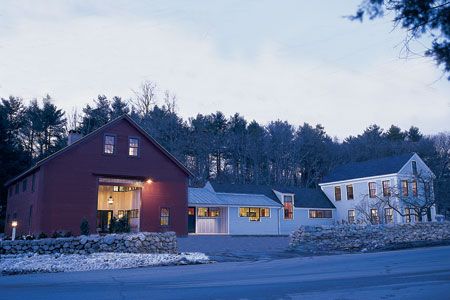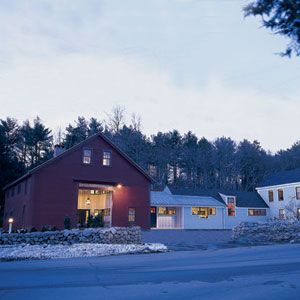
On a drizzly spring day just about 12 months ago,
This Old House bought a piece of history — an 1849 New England farmstead to renovate for TOH’s coming television season. A check for (gulp!) $643,000 was handed over, and the crew started in on their most ambitious project to date: remodeling the original Greek Revival house, converting the old barn into living space, and completely rebuilding the ell connecting the two. In the end, the guys were left with lots of memories and a remarkable finished house that’s now open for public snooping as a designer show house. They also ended up learning a lot — a renovation, it turns out, is very different when you own the place and aren’t just contractors on the job site. The lessons? About time and money well spent. About making decisions, easy and hard. About how best to blend the old and the new. The editors of this magazine figure you might learn a few things from their experience, too. So here’s a sort of TOH family scrapbook — a journey in words and pictures that ambles through the whole nerve-racking, fun, exciting, humbling, and rewarding endeavor. We hope once you read it through, you’ll be able to tackle your next renovation with a little more wisdom and a lot less worry.
A Mile in Your Shoes
The crew of This Old House started a collective personal journey the day we bought our rambling farmhouse last spring. Each of us began, then and there, to imagine ourselves and our families living in the house to be. Some of us were sleeping in a splendidly isolated master suite above the barn, while others thought how nice it would be to have the kids just upstairs in the old Greek Revival house.
With the help of architect Jeremiah Eck, we all came around to a unified vision: A public end of the building (the barn), a private end (the old main house), and communal spaces — the kitchen and dining room — in the new ell connector that links them together. It was then that our dual roles as homeowners and crew began.
Watching the excavator rip into the old ell, while exciting, also caused the more tenderhearted among us to wince. Not only were we taking down a piece of history, albeit a poorly built and barely functional one, but now we were really in it: no turning back, with the money tap fully open.
And so began the onslaught of small but important choices that, for decades, we’ve watched other homeowners stress over. Ante up for radiant heat? (Yes.) Which kitchen cabinets? (Custom, flat-panel, painted.) Same moldings throughout, or simpler in the barn? (Same throughout.) Sometimes we argued — usually over ceilings, for some reason. Should the bedroom in the new master suite have a cathedral ceiling? Was it worth the expense of raising the old ceilings in the kids’ bedrooms? Did it make sense to replicate the rustic beams of the barn on its new ceilings? In the end, we decided “yes” to all three.
We had the advantage of being able to give each other professional advice. Master carpenter Norm Abram and general contractor Tom Silva showed us how we could insulate and plaster between the barn beams, then skin one exterior wall (behind the fireplace) with structural insulated panels to preserve a piece of the barn fabric inside. Plumbing and heating expert Richard Trethewey designed a state-of-the-art HVAC system. Landscape contractor Roger Cook suggested a bluestone-and-granite patio based on another job he’d done. And interior design consultant Alexa Hampton created period-perfect Greek Revival moldings that we had made into new casings, baseboards, and crown.
Now that we’re finished, we’re probably like most homeowners — tired out, happy about most of our decisions, comfortable with our compromises, and just a little sad the big ride is over. But unlike most homeowners, we won’t inhabit the house we’ve built. Sadly, we have to sell our dream home. We can only hope the new owners will think fondly of the previous ones.
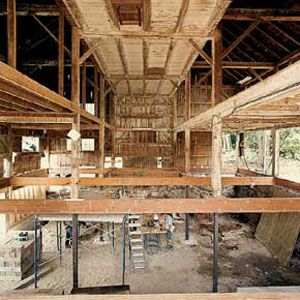
Lesson 1. A sound skeleton comes before flashy finishes
The unfinished 156-year-old barn had so much potential — big, open space and those cool rustic beams
But it also had issues, like a rotting floor and a sill you could stab through with a butter knife. So before the animal shelter could be made ready for people, the TOH crew — including host Kevin O’Connor, general contractor Tom Silva, and master carpenter Norm Abram — needed to jack it up.
They replaced the dodgy beams with hearty laminated ones, and built a new floor that would last at least the next 150 years.
Lesson 2. Low ceilings create cozy spaces
The barn’s soaring ceiling fills the great room with light and air, but sometimes you want an intimate little corner where the family can curl up and watch a good movie. An early plan enclosed the room’s media center, which is located beneath two new upstairs bedrooms, as a separate room. But since the space had a 7 1/2-foot ceiling, it was already a natural for a cozy TV alcove — without the closed-in feeling that additional walls would create. Now when the screen is dark, the area also serves as a snug spot for reading or conversation, brightened by two-story windows in the adjoining high-ceilinged space.
Lesson 3. Structure can be beautiful
We liked the barn so much when we first saw the house, we knew it needed to be living space. Its worn posts and nail-studded beams had too much romance for it to be any other way.
So as not to take away too much of that charm, Tom put 2×3 nailers and spray-foam
insulation between the wall beams on the interior, then covered that with board and plaster, which left the massive timbers partially revealed. But as a tip of the hat to what was once there, he covered the exteriors of the walls flanking the fireplace with structural insulated panels (SIPs), which meant the interior could be exposed down to the great barn boards.
Materials
Fireplace: Chimney Savers/Charlie Allen Restorations
Firebox Lining: Vermont Soapstone
Television: Tweeter Home Entertainment
Custom Media Cabinet: Norm Abram
Engineered Beams: Georgia-Pacific
Foam Insulation: Icynene
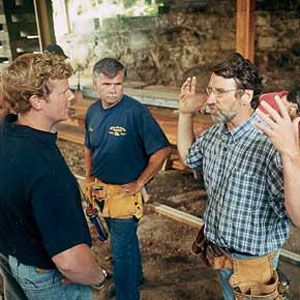
Lesson 4. There’s a place for art in the everyday
In a simple farmhouse, stairs often aren’t much more than a way to get from one level
to another. But that didn’t stop Tom and his crew from building a floating, full-height staircase
that has an inherent beauty. It’s supported by plywood sides that were cut from one sheet for both the steps and landing, then doubled up and sandwiched between two pieces of 5/4 poplar. The treads and risers were then slotted into grooves so the staircase could stand free of posts or stringers for four stories. A final eye-catching touch: They turned the balusters 45 degrees for a twist on tradition.
Lesson 5. Sometimes starting over is the smartest way to go
In the original house, the kitchen was a hemmed-in, poorly laid-out, knotty-pine-paneled room in the middle of the ell connector. Above it were some pretty crazy bedrooms — one with a 4-foot-high door. Structurally, aesthetically, and historically, there was nothing of merit to save.
The best way to create a real entry, kitchen,
and dining room in this odd space was to bring out the backhoe and reduce the structure to matchsticks.
Then build something altogether better.
Lesson 6. Smart window design can provide both light and privacy
The front of the Carlisle house faces
a main road, which means it isn’t the
right place for big picture windows
(good for curious passers-by, bad for nonexhibitionist homeowners). But
that south-facing side of the house also gets the morning light. So architect Jeremiah Eck placed a bank of windows high on the home-office wall to usher in sunshine without giving away the family secrets. Outside, simple green-gray siding sets off the row of dark-green windows, the middle one elongated just slightly to add visual interest.
Materials
Light fixture: Visual Comforts
Paint: Benjamin Moore
Wood Railing Stain: Varathane
Windows: Andersen Windows
Siding: James Hardie
Cabinets: Plain & Fancy
Appliances: Bosch Thermador
Granite Counters: Gerrity Stone
Wood Counters: Walker Creek Furniture
Range Hood: Broan-NuTone
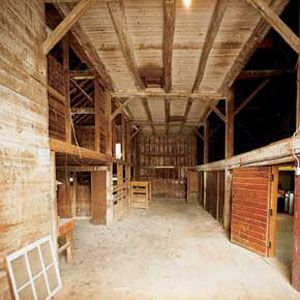
Lesson 7. Bigger isn’t always better
The original house plans had the kitchen running clear through from front to back in the
new ell. But one lap around the framed space made it clear that anyone preparing meals would
be logging miles, too. So we reconfigured the layout, narrowing the food-prep area to
make it smaller and more efficient. The rest of the footprint became an office, connected to the kitchen through an open doorway — convenient for those of us who bring our work home and need to fuel up for the extra 2 1/2 hours we put in each day.
Lesson 8. Drawings on paper only take you so far
While we believed the revised kitchen configuration was on the money, it took kitchen designer Kathy Marshall to work out the details. She recommended a walk-through of the layout in three dimensions to double-check the scale and placement of the components. Positioning cardboard boxes and sawhorses to represent the cabinets, counters, and island, we got a sense of just how well the work triangle of range-sink-fridge would function. We liked it so much, we built it for real.
Lesson 9. Sometimes Plan B is the better one
An early sketch of the master bath included a large linen closet and a tiny shower stall. The longer we lived with the design, the more we had our doubts about it. So we took another look at the whole space, made the linen closet smaller, set the toilet in what was to be the shower cubby, stole some space from the fireplace we decided not to build in the adjacent dining room, and created a spacious new shower.
Materials
Spa tub, shower spray: American Standard
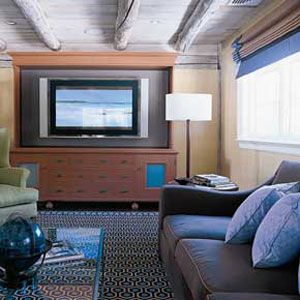
Lesson 10. Small luxuries make daily life a pleasure
A bathroom that’s outfitted to make a homeowner feel like royalty really ups the relaxation and comfort factor. The Carlisle master bath has
a deep spa tub, a large shower with a built-in limestone bench, limestone floors, handmade ceramic wall tiles, and big windows that flood it
with natural light. There’s even a TV hidden behind a two-way mirror over the vanity so you can catch those reruns — of, oh, maybe, This Old House — while having a soak.
Lesson 11. Great views belong in private spaces, too
It’s usually the public rooms in a house that showcase a spectacular view, but a bedroom is also a terrific spot to build in sight lines to the outdoors. Rather than turn our master suite into a second-floor cocoon, we took a page from homeowners who prefer a first-floor master suite — that’s more than half of you — and designed a ground-level bedroom that blurs the boundary between inside and out. Three floor-length corner window units take advantage of the room’s location, facing the very private backyard. And a vaulted ceiling adds to the feeling of expansiveness.
Lesson 12. Modern materials can speed up construction
Every project has its delays, and Carlisle was no exception. After a septic-tank issue halted work for weeks, Tom and his crew had a lot of time to make up. Luckily they had already planned to build the new ell from precast foundation panels and prefab structural insulated panel (SIP) walls.
While the the foundation was being prepared and assembled (in all of one day), the walls were essentially being framed in the factory. It took less than a week to put them up, and the strong SIP walls easily supported the many large window openings that the project called for.
Materials
Limestone, ceramic tile: Walker Zanger
Windows: Andersen Windows
Foundation: Superior Walls of America
Structural Insulated Panels: Insulspan
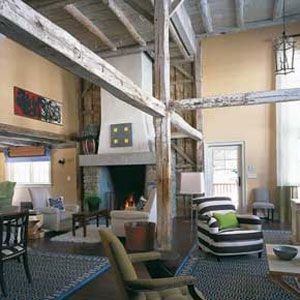
Lesson 13. Experts really do have expertise
When interior design consultant Alexa Hampton insisted that dark floors wouldn’t look out of
place in our country farmhouse, we blanched. But then we saw the Brazilian cherry in place and realized how well it tied the different parts of the house together. Not only are the floors made
of easy-to-install engineered planks with a durable factory-applied finish, they also serve as a perfect backdrop for light-colored architectural details and furniture pieces, like the custom-built barrister bookcases in the library.
Lesson 14. Man-made can be better than the real thing
A 156-year-old house should have heavy wood doors that close with a thud and keep noise from filtering through. Though it certainly would be appropriate to the house’s Greek Revival style, a solid-wood six-panel door is expensive and, as anyone living in an old house can tell you, prone to warp, split, and stick as it shrinks and expands with the seasons. The doors at the Carlisle house are made from medium-density fiberboard (MDF),
a very stable and hearty compressed-fiber product that feels like solid wood but performs better in changing weather. No splits, no warps, but otherwise indistinguishable from the real thing.
Lesson 15. It’s worth the extra effort to save a bit of history
Never mind the fact that the people of Carlisle would have lost a major landmark if we’d torn down the Greek Revival part of the house. We didn’t want to do it anyway; it was too special an example of a vernacular style, one worth working to restore.
Problem was that key sections of the frame and a lot of the skin had to be replaced.
Only thing to do was to strip it and gut it but try our hardest to preserve the historic shell and give it back its Greek Revival details.
Materials
Floors: Mannington Mills
Bookcases: New England Woodworking
Doors: TruStile Doors
Mantel: E.H. Taylor Fine Cabinetry
Trim: Spectis Moulders
Gas fireplace: Valor Fireplaces
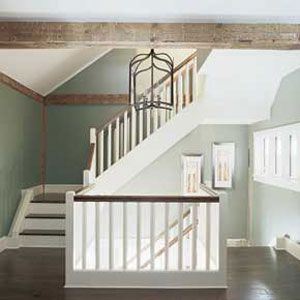
Lesson 16. Every house could use a few surprises
Since finishing the basement is near the top of the to-do list for most homeowners (second only to adding a deck), we decided to give the future residents of the Carlisle house a leg up by building in a bonus room just below the main living areas. And not just any old room, but a well-appointed, temperature-controlled wine cellar that’s lined in redwood, with a tiled tasting bar and big windows — a definite destination when guests come to call.
Lesson 17. Comfort and utility aren’t mutually exclusive
Wire shelves, peel-and-press floors, electric-white paint. The laundry room gets no respect and so is rarely comfortable to work in — troubling, given the 7 hours most of us spend with a stain stick each week. That’s why, in addition to putting in the requisite washer and dryer, we upgraded with a drying cabinet and a jetted sink (for hand washables), then finished the space with furniture-grade cabinets, hardwood floors that match those elsewhere in the house, and even a flip-down television to pass the time while folding.
Lesson 18. The best investments are often hidden
Let’s face it: systems aren’t sexy. But they keep the place going. And comfortable. Entertaining, even.
A lot of thought went into how to cool the house without waking the neighbors every time the air went on.
Dealing with waste from five toilets (plumbing and heating expert Richard Trethewey installed a new septic tank.
A central box connects the lights, media, surveillance, and alarms that allows for touchscreen controls throughout the house.
Those decisions made, we could relax, knowing everything would soon be up and running.
Materials
Wine cellar: Wine Cellar Innovations
Laundry appliances: Whirlpool
Air-conditioning: Carrrier
Septic tank: Shea Concrete
Home Automation: Tweeter Home Entertainment
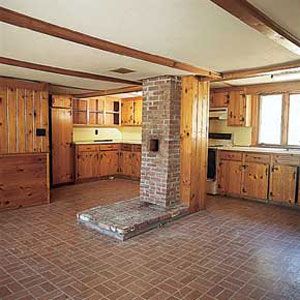
Lesson 19. Native materials marry a house to the land
When early American farmers built their stone walls, they simply used rocks unearthed while cultivating their fields. At Carlisle, all the new stone walls, built from local fieldstone, look like they worked themselves right out of the ground.
Landscape contractor Roger Cook prepared their bases well so they won’t move an inch when winter frost heaves hit.
He also recycled giant blocks of granite, once used to cap the old ell’s foundation, for steps that link the lower and the upper driveways.
Lesson 20. Entryways should signal what’s coming
The great thing about the Carlisle house is that it has several distinct spaces, from the broad, earthy barn to the sleeker contemporary ell to the more traditional Greek Revival house. The challenge was to create seamless transitions between these disparate sections of the house, giving a hint of the rooms to come as you move from one part to another. So the wide doorway leading from the house’s main entry hall — in the ell — into the barn was framed with rough-hewn beams. Similarly, the barn’s quartzite-paved entry court — revealed when the original sliding barn door is left open — was given large-scale dimensions and a two-story ceiling height to prepare visitors for the big, soaring space that lies beyond the French doors.
Lesson 21. Houses need spaces for year-round entertaining
Summer barbecues. Winter holidays. Fall football season. A house with lots of different places that can handle a crowd becomes a magnet at gathering time. The Carlisle farmstead has several, including the formal dining room off the kitchen, the bluestone patio out back, and the barn’s great room, which opens onto the porch — a feature once typical of American houses that’s enjoying a revival in new home construction. Overlooking the tree-lined backyard, this one has three-season appeal, thanks to screens that can be raised and lowered with the flip of a switch.
Materials
Stone wall: O’Hara & Company
Barn lamp restoration: Yankee Craftsman
Quartzite: Walker Zanger
Retractable screens: Phantom Screens
IPE decking: Anderson & McQuaid Company
Ceiling fan: Shades of Light
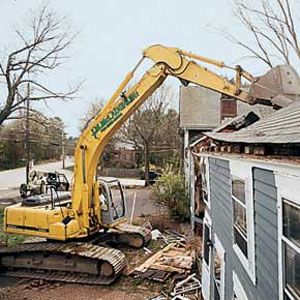
Where to Find It
Architect:
Jeremiah Eck, Jeremiah Eck
Architects Inc.
Boston, MA
617-367-9696
Interior design consultant:
Alexa Hampton
Mark Hampton Inc.
New York, NY
212-753-4110
Kitchen designer:
Kathy Marshall, CKD
K. Marshall Design Inc.
Hamilton, MA
978-468-7199
Lighting designer:
Susan Arnold
Wolfers Lighting
Waltham, MA
781-890-5995
Landscape architect:
Stephanie Hubbard
Halvorson Design Partnership
Boston, MA
617-536-0380
Electrical contract:
Gallant Electric Inc.
Bedford, MA
781-862-4636
Plumbing and heating contractor:
Trethewey Bros. Plumbing & Heating
Roslindale, MA
617-325-3283
Landscape contractor:
Roger Cook
K & R Tree and Landscape
Burlington, MA
781-272-6104
Interior demolition:
Gagliard Contracting
Westwood, MA
617-650-3194
Exterior demolition and excavation:
James M. McLaughlin Inc.
Lexington, MA
781-862-4851
Barn-jacking contractors:
Northeast Building Movers
North Hampton, NH
603-926-6426
www.northeastbuildingmovers.com
Precast foundation:
Superior Walls
New Holland, PA
800-452-9255
SIPs:
Insulspan
Blissfield, MI
517-486-4844
Northeast Insulspan distributor and SIP installer:
Panel Pros
Keene, NH
800-721-7075
Plaster contractor:
Stephen’s Plastering & Contracting Services
Winchester, MA
781-721-7315
Painting contractor:
Clark Painting Corp.
Sudbury, MA
Finishing specialist:
John W. Dee Painting & Decorating
Concord, MA
978-369-8897
Wood flooring contractor:
Hunt Hardwood Floors
Lexington, MA
781-862-3559
Tile contractor:
Joe Ferrante
Ferrante Tile
Medford, MA
781-396-6327
Dry-set stone wall contractor:
O’Hara & Company
Ashland, MA
508-881-6851
Mason:
Lenny Belliveau
Lenny’s Masonry
978-897-6256
Antique lighting restorers:
Yankee Craftsman, Inc.
Wayland, MA
508-653-0031
Roofing contractor:
Home Depot At-Home Services
Custom Furnishings:
Norwalk Furniture Corp.
Norwalk, OH
419-744-3200
Apprentice school:
Minuteman Regional High School
School of Applied Arts and Sciences
Lexington, MA
781-861-6500
Building materials, systems, and tools?
Engineered lumber:
Georgia-Pacific Corporation
Atlanta, GA
404-652-4000
Engineered wood floors:
Mannington Mills Inc.
Salem, NJ
800-482-9527
Ipe decking:
Anderson & McQuaid Company
Cambridge, MA
617-876-3250
Random-pattern bluestone:
Cavicchio Greenhouses Inc.
Sudbury, MA
978-443-7177
Custom MDF interior doors:
TruStile Doors, LLC
Denver, CO
888-286-3931
Windows and French doors:
Andersen Windows
800-426-4261
Fiber cement siding:
James Hardie Smooth Hardiplank Siding
Mission Viejo, CA
888-542-7343
Asphalt roof shingles:
CertainTeed Corp.
Valley Forge, PA
610-341-7000
Cedar shingle panels:
Cedar Valley Shingle Systems
Hollister, CA
800-521-9523
Spray foam insulation:
Icynene
Mississauga, Ontario
905-363-4040
Borate-based termiticide:
Bora-Care
Nisus Corp.
Rockford, TN
800-264-0870
Interior and exterior paint:
Benjamin Moore
Montvale, NJ
800-344-0400
Caulk, sealants, and adhesives:
GE Sealants & Adhesives
866-275-4372
Air-conditioning system:
Carrier Corp.
Farmington, CT
800-227-7437
Radiant heat system:
WIRSBO Company
Apple Valley, MN
800-321-4739
Generator:
Guardian Home Standby Generator
Generac Power Systems Inc.
Whitewater, WI
800-333-1322
Monolithic dual-compartment septic tank:
Shea Concrete
Wilmington, MA
978-658-2645
Garage storage system:
Gladiator Garage Works
Whirlpool Corp.
Benton Harbor, MI
269-923-5000
TOH crew truck:
2004 GMC Sierra 2500 Professional Series
General Motors Corp.
Detroit, MI
800-462-8782
Power tools:
Hitachi Power Tools
Norcross, GA
800-829-4752
Radiant heat system:
WIRSBO Company
Apple Valley, MN
800-321-4739
Barn interior ?
Designer:
Eric Cohler Design
New York, NY
212-737-8600
Media system:
Tweeter Home Entertainment
TV program recorder:
TiVO
877-289-8486
Chimney specialist:
Mark Schaub
Chimney Savers
Hillsborough, NJ
888-576-4574
Chimney repair contractor:
Charlie Allen Restorations Inc.
Cambridge, MA
617-661-7411
Firebox lining:
Vermont Soapstone Co.
Perkinsville, VT
802-263-5404
Stairway ?
Handrail finish:
Varathane Polyurethane Rust-Oleum
Vernon Hills, IL
800-553-8444
Lighting fixture:
Visual Comfort
Houston, TX
713-686-5999
Kitchen ?
Cabinetry:
Plain & Fancy Custom Cabinetry
Schaefferstown, PA
800-447-9006
The Cabinetry Kitchen Design Studio
Hanover, MA
781-829-9123
Kitchen installers:
Andrew Stevens Company
Gloucester, MA
978-282-1429
Cabinetry hardware:
Baldwin Hardware Corp.
Reading, PA
800-566-1986
Faucet:
Culinaire Pull Down
American Standard
Piscataway, NJ
800-442-1902
Sink:
London Farm Sink by Porcher
American Standard
66-455-6118
Appliances:
Thermador
Huntington Beach, CA
800-735-5547
Dishwasher:
Bosch Appliances
Huntington Beach, CA
800-921-9622
Range hood:
Broan-NuTone LLC
Hartford, WI
262-673-4340
Granite countertops:
Gerrity Stone
Woburn, MA
781-938-1820
Custom mahogany countertop:
Walker Creek Furtniture
Essex, MA
978-768-7622
Flat-screen wireless TV:
Sharp Electronics Corp.
Mahwah, NJ
201-529-8200
Wall-mounted sconces:
Schoolhouse Electric Co.
Portland, OR
800-630-7113
Master suite ?
Bedroom designer:
Frank Roop Design + Interiors.
Boston, MA
617-267-0818
Bathroom designer:
Alexa Hampton
Mark Hampton Inc.
Limestone and ceramic tile:
Walker Zanger
Sun Valley, CA
818-504-0235
Library ?
Designer:
Charles Spada
Charles Spada Interiors
Boston, MA
617-204-9270
Custom built-ins:
New England Woodworking
Middletown, RI
401-841-5544
Mantelpiece carpentry:
E.H. Taylor Fine Cabinetry
Yardley, PA
Custom polyurethane moldings and window trim:
Spectis Moulders Inc.
Niverville, Manitoba
800-685-9981
Supplied by Architectural Elements Inc.
Boxborough, MA
800-399-0268
www.architectural-elements.com
Custom wine cellar ?
Wine Cellar Innovations
Cincinnati, OH
800-229-9813
Laundry room ?
Designers:
Katy Flammia, AIA
Susan Greco, IIDA
THEREdesign Ltd.
Boston, MA
617-782-0833
Laundry suite:
Whirlpool Corp.
